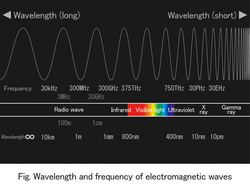Nagoya City Science Museum
TOP > Exhibition Guide > Keyword Search > Starting with "H" > Hertz > Electromagnetic Wave
Electromagnetic Wave

Purpose of Exhibition
Light, radio waves, infrared-rays, X-rays, etc. are all included in the same category. They are called electromagnetic waves. Electro-magnetic waves have the characteristics of waves, and each wave is categorized as electro-magnetic waves or ultraviolet rays according to differences of wavelength. In this exhibit, one can recognize the characteristics of each wave.


Additional Knowledge
Electro-magnetic waves, in order of wave length, are: radio waves, infrared rays, visible light waves (light), ultraviolet rays, x-rays and gamma rays.
[Electro-Magnetic Waves]
Electro-magnetic waves are used in everyday items such as televisions, radios, and mobile phones.
The existence of electro-magnetic waves was predicted by a British physicist, Maxwell in 1864. This discovery led to a formula. That formula indicates that light has the characteristic of an electromagnetic wave. That was the basis for the subsequent development of applied physics.
A German physicist, Hertz, has demonstrated the presence of the predicted electro-magnetic waves in an experience in 1888. The same experiment is conducted in this exhibition.
Waves longer than 0.1 mm are commonly referred to as electro-magnetic waves; there are no clear boundaries with infrared.
[Infrared Rays]
Remote controls of television communicate with television through infrared rays. Mobile phone cameras and digital cameras can detect infrared rays which are invisible to our eyes, so if you point a remote control, you can see the light of the infrared rays.
By observing the sunlight trough a prism, you can see the seven colors of the rainbow. They are divided into red, yellow, green, and blue. If you place a thermometer outside the red color, you can notice that the temperature rises. It may seem as if light is not present, but due to the rise in temperature it means we can assume that light does exist.
In this way, infrared rays were discovered by German astronomer Herschel in 1800. Waves with a length between around 800 nm and 1 mm are called infrared rays.
[Visible Light]
Common light is called visible light.
Literally, it is the light that can be seen by humans and divided through a prism from red to blue.
Waves with a length between 400 nm and 800 mm are called visible light.
[Ultraviolet Rays]
As we are familiar with, ultraviolet-rays are the rays of light which causes sunburn (UV).
If there was an infrared ray outside the red of the spectrum, it was presumed to be something other than violet, and so ultraviolet rays were discovered in 1801, the year after the discovery of infrared rays.
Waves with a length around 1 nm to 400 nm are called ultraviolet rays. The boundary between ultraviolet and X-ray is not clear.
[X-Rays]
X-rays are used for X-ray photography and radiography.
They are used because of their superior ability to make material transparent, and therefore are used to create such images.
X-rays were discovered by the physicist Roentgen from Germany in 1895 as an unknown radiation that made a fluorescent screen bright through rays. When discovered, the nature of the radiation was unknown, therefore, the term 'x-rays' was adopted and is still used today. In 1912, X-ray diffraction was discovered by another German physicist, Laue.
Once x-ray diffraction was discovered, it was proved to be an electromagnetic wave. In 1901, Roentgen was awarded the first Nobel Prize in Physics.
[Gamma Rays]
Gamma rays are indicated by _.
Compared to other electromagnetic waves, these waves are less familiar.
They are generated by reaction to stimulations of atoms and particles.
They were discovered by a French chemist, Paul Ulrich Villard in 1901.
As radioactive waves with high penetration ability, they were named gamma rays in 1903 by Rutherford. Waves shorter than 0.01 nm are called gamma rays. The distinction between X-rays and gamma rays is not the wave's length, but the mechanism generated.
Article by Yoshitaka Yamada, curator
